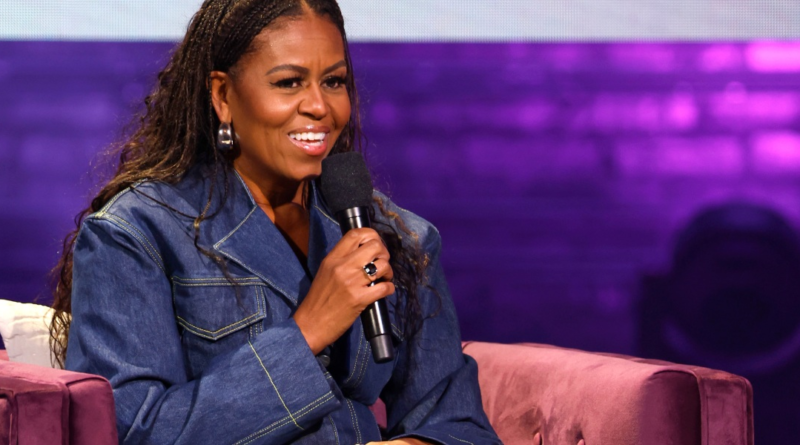Michelle Obama shares her advice for success on book tour, including overcoming fear, shutting down your inner critic, and radical self-care
Michelle Obama didn’t proverbially let her hair down until she left 1600 Pennsylvania Avenue. Last month, in Philadelphia, on the one of the first stops of a tour for her new book, The Light We Carry, Obama imprinted a version of herself that she wasn’t allowed to show while living in the White House: She wore a silky black matching pants set and donned tiny braids and a kinky ponytail.
When asked about her braids, she wore a relieved expression. “[Braids] are an important protective style,” she explains. “As public figures, we’re getting our hair fried and dyed,” she says referring to the conservative image she needed to put forward. “For eight years I was praying, ‘Just let me have some hair on my head.’”
She expressed that being outside of the White House has made her voice louder.
“We have become so divided. You put a D or an R on your chest, and you alienate one half of the country. Outside of politics, people can hear me better.”
Each chapter of The Light We Carry offers readers just that—a chance to hear from a vulnerable, stripped-down version of a highly revered woman. Behind that squeaky-clean image is a woman who battles with insecurities and fears. Self-care messages are baked in throughout, and the book serves as a self-help tool kit.
Obama offers a hopeful message, as she did in her first book, Becoming. This time she talks about using the pandemic as a time to jump into radical self-care. Like the rest of us, she fretted over making sure elderly loved ones were safe; she wondered if her young adults were being responsible and whether or not she had enough toilet paper. Also, like the rest of us, she took up a new hobby—knitting occupied her hands and helped to quiet her mind.
“Knitting isn’t just for old ladies,” she mused onstage. “Unbeknownst to me, knitting was meditative. When you shut your mind off and you let your hands do the work, there’s something clarifying in it.” Coming from a family that sewed and knitted, she felt that it was her inheritance—something that would have surprised her younger self.
An important part of Obama’s self-care message was not only finding an outlet, but also managing fear, which was crucial for navigating COVID lockdowns and when she started writing the book. Pandemic or not, the message to not let fear lead the way reverberates.
Obama dedicates a whole chapter to how fear disconnects us from our truth and from others.
She explained, “Fear is a necessary evil, right? It keeps us safe.” Anyone who’s grown up like her, on the South Side of Chicago, knows that fear can keep us out of trouble, but she believes that we shouldn’t give it too much power. If she hadn’t sat and listened to what her fear was trying to say, her husband might not have run for president.
Sometimes that fear is rooted in self-doubt, and despite having lived in a prestigious house, even she has to battle with it.
“I wanted to be perfect,” she told the audience. “But now I don’t feel like I need to prove anything. Excellence is now my habit.”
Nonetheless, leaving the White House revealed two realities: “The bad news is that [leaving] hasn’t eliminated fear and doubt in my life. The good news is that I’m not intimidated by my own thoughts anymore.”
A major part of standing resolute in your truth is “boxing out your inner critic.” Another is having a circle that can validate your experiences and help you keep perspective. Relationships can be everything when self-doubt sneaks in.
Obama reminds us of the importance of forging friendships, something that many adults struggle to do or seem to neglect. “Friendship is a tool that has sustained me my entire life,” she recalls. Starting a family and an intensive work schedule may force us to miss out on connections that feed us mentally, spiritually, and socially. The former first lady learned early into the presidency just how difficult it could be, but nonetheless, despite clearances, secret service, and snipers, she was able to form a girl group as tight as “Survivor”–era Destiny’s Child.
Combine these messages, plus many more, that are sprinkled throughout her book, and you have not only a revealing look at the former first lady, but also a map to harness your light.
Our new weekly Impact Report newsletter will examine how ESG news and trends are shaping the roles and responsibilities of today’s executives—and how they can best navigate those challenges. Subscribe here.

